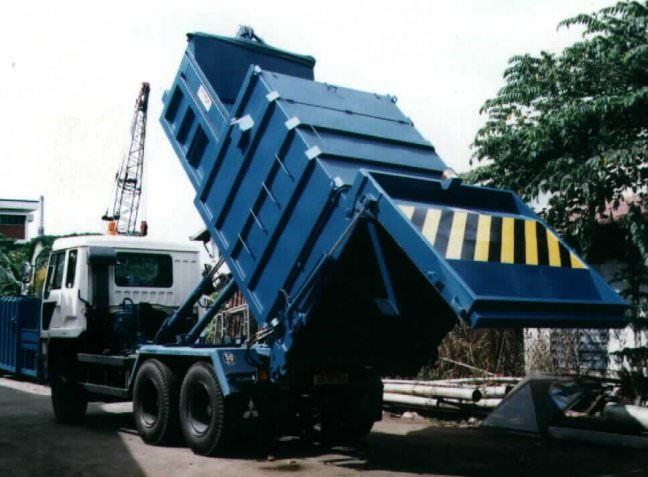
Many people are unaware that Singapore residents generated an average of 1.77 million tons of domestic waste in 2022. With that in mind, it’s clear that the country needs to have an effective garbage disposal system in place. Equally important are the garbage trucks that are tasked with removing all this waste.
What is a Garbage Truck?
A garbage truck is a vehicle specifically designed to collect municipal solid waste. The collected waste then needs to be transported to a solid waste treatment facility. Garbage trucks feature compacting mechanisms and hydraulic cylinders that compress garbage to fit more into the truck.
History of Garbage Trucks
Garbage trucks were first introduced in 1929 in the form of the Heil Collector. This innovative design featured a bucket hopper on the side of the truck which would essentially lift trash and then dump it into the rear of the vehicle. This would happen through an opening at the top.
In 1938, the Garwood Load Packer completely revolutionized the waste management industry when adding a compactor to the design made the process considerably more effective. The first compactor was almost double the truck’s capacity and worked with a hydraulic press.
The 1970s saw the introduction of the first grapple trucks that were used for municipal waste collection. The world’s first automated side loader was introduced in Scottsdale Arizona. This impressive new truck could easily collect 300-gallon containers in about 30-second cycles. An impressive feature was that this could be done without the driver exiting the vehicle.
How Does a Garbage Truck Work?
You’ve no doubt seen a garbage truck in action. In fact, you may have seen garbage going in and being compacted. But what’s the science behind the whole process? Here are a few simplified steps to highlight how the process works.
- Step 1: Garbage trucks are driven down local city streets where rubbish is collected on pre-determined days.
- Step 2: Trash is picked up by garbage collectors and placed into the hopper of the truck.
- Step 3: The compacting mechanism removes the rubbish from the hopper and deposits it into the truck’s body.
- Step 4: Hydraulic cylinders control the junk inside the truck and prevent it from falling out of the sides.
- Step 5: The compacting device is situated on the exterior of the truck which allows for more space inside the truck.
- Step 6: When the garbage truck is full, the driver transports the rubbish to the local dump or waste management facility.
- Step 7: Hydraulic cylinders move the compacting panels out of the way as the vehicle tilts up.
- Step 8: The rubbish is tossed out of the vehicle and the inside of the truck is hosed out for the next trip.
Different Types of Garbage Trucks
With the innovations in garbage removal, it’s not surprising that there are different types of garbage trucks to choose from. Essentially, the type of garbage that needs to be removed will determine the type of truck you should consider hiring. There are four main categories of garbage trucks to choose from. These are discussed below.
1) Front Loader Garbage Trucks
For the most part, front loaders are garbage trucks that feature automatic forks in the front of the cab. These trucks are primarily used to empty commercial waste bins such as the huge dumpsters you see outside restaurants. With these vehicles, the dumpster is lifted up and emptied into the truck box.
Some of the benefits of front-loader garbage loaders include the following:
- Many models can lift about 8000 pounds of waste.
- Ideal for dumpster-based waste systems.
- Hydraulic arms can easily lift commercial trash containers.
2) Side Loader Garbage Trucks
With side-loader garbage trucks, the rubbish is collected on the side of the truck. These trucks can be operated manually or automatically and are usually used for residential waste collection and disposal.
In most instances, these trucks are driven by a single person who also controls the side-loading process from the driver’s cab. Manual versions may require a driver’s assistant who will control the lifting mechanism.
The top benefits of using a side loader garbage truck are listed below:
- Ideal for residential areas
- Newer models make use of an electronically controlled hydraulic arm, making them more efficient.
- In most cases, this garbage truck type only requires one operator which provides a reduced manpower cost.
Below is a short clip that shows how a side loader garbage works.
3) Rear Loader Garbage Trucks
Another popular type of refuse equipment is the rear-loading garbage truck. With rear loaders, the garbage is gathered from the back. This process works by employees throwing trash bags and bin contents into a big container inside the truck.
Once the container is full, the contents are compressed. These rear-loader garbage trucks can be used for both residential and commercial waste removal. The most common benefits of using a rear-loader garbage truck include the following:
- Rear loaders are perfectly designed to remove the residential waste collection.
- While they use human workers to empty the garbage into the onboard bin, these trucks can provide waste removal services for more than 800 homes in a single day.
- With fewer moving parts, the rear loader truck type has minimal chance of breaking down.
- These trucks are also easy to manoeuvre through narrow streets which may present a problem for their larger counterparts.
Below is a short clip that shows how a rear-loader garbage truck works.
4) Roll Off Garbage Trucks
Commonly used for commercial waste removal, roll-off garbage trucks can also be used to gather huge amounts of waste at construction and demolition projects. It’s ideal for moving oversized items.
Essentially it works by having a dumpster box mounted on a customized roller chassis or trailer that enables the box to be rolled off the truck and left at the job site. Once the box is full, it’s tolled back onto the garbage truck where it is then taken to the landfill or treatment facility for disposal.
A few of the benefits that make roll-off garbage trucks so popular are listed the following:
- They can carry about 10 tons of refuse at a single time.
- Roll-off garbage trucks have a larger degree of flexibility that the other types of garbage trucks simply can’t match.
- The mechanical simplicity of the roll-off process makes it less likely to experience technical problems than some of the other garbage truck types.
- These garbage truck types are among the easiest garbage trucks to operate and maintain.
Work with Syntech your Garbage Truck
Whether you’re reading up on garbage trucks because you need to rent one, or you simply have a keen interest in how the whole process works, this article would have answered all your questions.
Understanding the different types of garbage trucks will make it easy for you to find the right vehicle for your garbage disposal needs.
ENQUIRE WITH SYNTECH ON PROCURING YOUR OWN GARBAGE TRUCK
FAQs
-
What is between a dump truck and a garbage truck?
In many instances, dump trucks and garbage trucks are often mistaken for the same thing. However, the key difference results from ownership of the truck. Often classed as commercial vehicles, it’s important to understand the difference. A dump truck is primarily owned by a construction company and driven by a qualified employee.
Furthermore, a dump truck might also be owned by a rental company and driven by the renter. On the other hand, garbage trucks are primarily owned by the city, county, state, or private company that works for the city.
-
How much trash can a garbage truck hold?
If you’ve seen garbage trucks around town then you know that they come in a wide range of different shapes and sizes. An average type of garbage truck can easily hold an estimated 20 tons of garbage before needing to be emptied out.
-
What is the lifespan of a garbage truck?
As with any other vehicle, the lifespan of a garbage truck depends on how it’s maintained. That said, the average garbage truck can last between 10 and 15 years with regular maintenance. In many instances keeping trucks for a total of 15 years can be challenging because there are often industry changes and weighing options that could influence how long your garbage truck stays operational.
